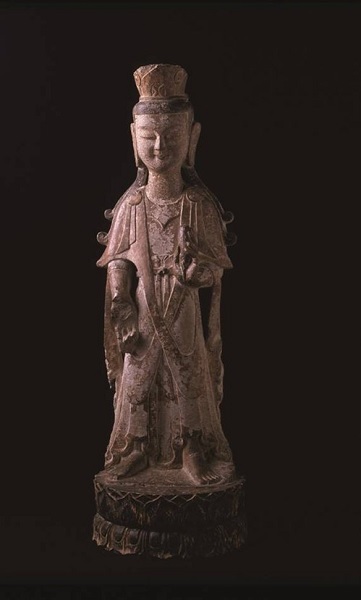
Unknown
Chinese
Standing Bodhisattva Padmapani, the Lotus-Bearer, 500 CE, about
limestone with traces of polychrome pigments, wooden lotus pedestal is a 20th century addition
35 1/4 x 12 1/2 in.
SBMA, Gift of Wright S. Ludington
1968.33.1
COMMENTS
This beautiful stone sculpture, with downcast eyes and a gentle smile, represents Padmapani, the Lotus Bearer, identified by the lotus bud he holds in his left hand. He is one of the earliest types of Buddhist figures introduced from India to China and is the earliest Buddhist sculpture in SBMA's collection.
By the 5th and 6th centuries, Buddhism and Buddhist image-making flourished for the first time in China under the state patronage of the Toba Wei rulers in the north. Padmapani, like other Buddhist figures, emerged from earlier Indian heroic-looking votive models to figures with more Chinese features and gentler demeanors, attesting to the brilliant role artists played in molding once-foreign visions of Buddhist imagery to appeal to Chinese devotees.
Padmapani here is fully clothed in a robe and wearing a cape-shawl which loops around his body. His garments and ornaments, including his cylindrical, trifoil crown, were influenced by the prevailing Confucian dress of the Wei court. This sculpture was originally part of a larger assemblage of Buddhist fig-ures in a cave temple. He greets the viewer from above with his right hand stretched out in a “no-fear” gesture (abhaya mudra). The lotus bud he holds serves as a metaphor for enlightenment, as it blossoms amid murky waters. SBMA’s Padmapani is somewhat squat with a disproportionally large head. These odd proportions may be a purposeful choice on the part of Wei artisans to visually compensate for the sculpture's placement on high, rocky cliffs. Such adjustments to normalize proportions from different vantage points may be seen on other Wei sculptures now removed from their original cave temples. Padmapani was also one of the earliest forms in which Guanyin, or Avalokitesvara in Sanskrit, the great Bodhisattva of Compassion, appeared in China. Of the myriad of bodhisattvas, all of them bound to the enlightenment path with the vow of liberating all sentient beings before entering Buddhahood, Guanyin emerged over the centuries as China's most beloved deity who protects and grants wishes to anyone who calls upon him.
- Susan Tai, Elizabeth Atkins Curator of Asian Art
